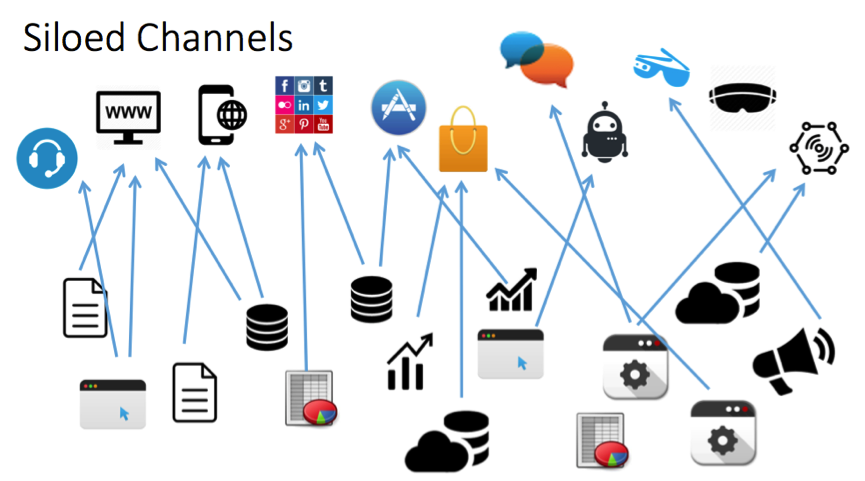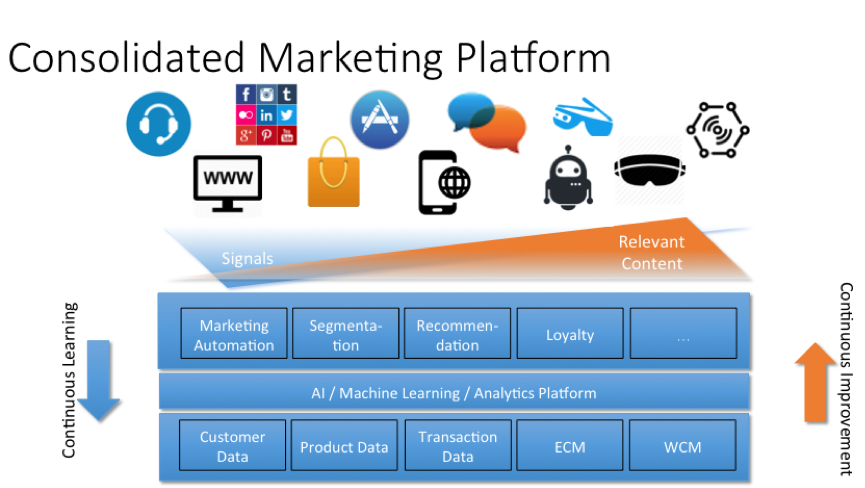These days, customer experiences increasingly need to be delivered with the help of technology. This does not mean that direct interactions and people are no more important in marketing, sales, or service; on the contrary, but that an increasing number of customers is using the web, social media, chat, or an app to identify suitable products or services or to resolve an issue, when needed. The Customer Executive Board found that 57 per cent of the buying process is already completed before sales personnel get engaged. A Cisco retail study confirms the American Express findings and states that around 60 per cent of all in-store purchases start their journey electronically. The American Express Global Barometer claims that 60 per cent of all customers abandoned a purchase because of poor service experiences.
Over the past 20 or so years the way products and services get sold and customer service as well as marketing get delivered to customers changed dramatically. Gone are the times where a potential customer was addressed via a radio- or TV-spot or an ad printed in a newspaper, or a letter in the mailbox … – well, it still happens, but the focus shifted.
We started off from one single, unidirectional marketing ‘channel’ – the customer comes into my store and interacts with me, a person. From there on we added an ever increasing number of additional channels, like the ones mentioned, plus many more.
In today’s omni-channel world we also have telephone, e-mail, web-delivered ads, mobile apps, branded and white-label communities, social media like Facebook, Instagram, Twitter, etc., chat, messenger applications like WhatsApp, FB Messenger, Snapchat, iMessage, and what not. The list could virtually go on and on.
And it is growing on a nearly daily basis.
Gone are the days where marketing was a simple task.
Google finds that 99.8 percent of all online ads are simply … ignored. Users do not interact with them at all. They are not perceived as relevant. This is because they are lacking the person’s context when served.
E-mail campaigns show a higher opening rate albeit often with low click-through rates. Still, even the opening rates are mostly underwhelming.
What does this mean? It shows is that marketers do not start meaningful conversations with customers by providing them with information that is relevant in their context but are blasting out poorly targeted and therefor mostly irrelevant messages. I really love how SAP’s Volker Hildebrand dubs it: “Marketing has become a weapon of mass distraction”.
The Zero Moment of Truth nowadays regularly happens on a smart phone, before the business knows of any purchasing interest. This means that companies need to be present already at the start of the search interaction. How to achieve this?
From there on, customers follow their own buying journey, using touch points provided by businesses in a sequence and timing of their own choice. They do not follow prescribed customer journeys. They still expect that companies to be better informed then they are themselves – apart from being easy to make business with or being where they are.
Customer experience is only as strong as the weakest part of the journey. A bad experience gets remembered longer or shared more often than a good one. This is bad news for businesses – but it is human nature. And it means that from the Zero Moment of Truth on businesses need to deliver a consistently high customer experience. Again, how to achieve this?
Customers, in particular consumers, spend more and more time in messaging apps; in fact they meanwhile spend more time in messaging apps than on social media sites. This trend emerged in the past few years and it shows that the landscape is continuously changing.
Customers also tend to use different devices and different channels when searching for a solution to their needs or wants, and when communicating with peers to get opinion that they value. Still they expect a business to know what the business should know about them, and to personally address them with contextually relevant information and to be ‘a step ahead’.
Third, customers also expect a company to not collect an inordinate amount of data about them – and to use it only to help the customer. They expect companies in a quid pro quo to return value, which may be perks, discounts, the company remembering them and their preferences, or benefits like premium information.
This is a very tall order!
The combination of cross-channel- and context (i.e., real-time) requirements creates the double challenge of keeping track of customers’ identities and intents across devices and channels while not being overly intrusive.
At the same time companies have regularly not yet reached an ‘omni-channel’ stage but are still working on achieving a seamless experience, regardless of the communications channel a customer uses at any given time; including as per yet unknown channels.
The Single View on the Customer is the Holy Grail
The requirement is the ability to identify a customer, regardless of device and channel, and to provide him/her with contextually relevant information, in real time.
At its core this requirement is about customer data and its beneficial usage – beneficial for both, the company and the customer. Currently, according to a 2015 study executed by Forrester Research for SAP Hybris, marketers use on average 15 different systems.
One could say these are 14 too many.

The resulting scattered data is preventing marketers from addressing customers in a timely and contextually relevant maner, as it is in between difficult and impossible to keep the systems aligned, even if they all happen to be controlled by the business and not by an external provider, e.g. a mail house doing mail- and email campaigns.
The main means of fulfilling these requirements is as much consolidation and centralization.
Consolidation and centralization of customer data.
And incorporating this data on one platform, along with data on preferences, actions, transactions, product data and content.
In one term, a Consolidated Marketing Platform.

The Consolidated Data Platform is more than a Customer Data Platform (CDP) or a Data Management Platform (DMP). According to David Raab a CDP is “a marketer-controlled system that creates a unified, persistent customer database which is open to external access. In other words, it’s designed specifically to meet marketers’ data unification needs.” A DMP is a data warehouse“ that sucks up, sorts and houses information, and spits it out in a way that’s useful for marketers, publishers and other businesses.”
While both are not the same albeit having a good overlap and are important to have, they are only milestones on a road. A Consolidated Data Platform is more – and it is the ultimate destination.
But!
From a marketing point of view the Customer Data Platform is an important milestone. Just that it should not be marketer controlled and that marketers are only a client. As are sales- and service departments. Consider e.g. an intelligent CPQ solution, or the automated delivery of relationship intelligence, which is a topic for another article of this series.
What does It Mean
Business leaders are wise to follow a Think Big, Act Small strategy, keeping the objective of identifying a customer, regardless of device and channel, and to provide him/her with contextually relevant information, in real time, in mind.
In order to hit the ground running, start with identifying what data points are collected, and can get collected and gradually integrate this data into a software architecture that fulfills four criteria.
- Has open interfaces to support the real-time connection of current and future source data systems in order to stay abreast of activities, behaviors, and intents. The data streams received by the system are continuously used to feed and refine models that determine the contextually right information to the customer
- Collects and meaningfully manages this data and creates a rich and dynamic customer record, so that the customer’s context, behaviors and interests can get used to provide positive experiences to the customer by execution applications. This rich and dynamic customer record is used in combination with other data to deliver contextually relevant messages to the customer
- Offers an advanced analytics engine with predictive and learning capabilities in order to create micro-segments and segments of one in real time, using intelligent, predictive models, and that can discover in real time opportunities of interest for the customer, based upon the current context. This engine is responsible for continuously adapting to changing contexts and interests, so that the company’s messaging stays relevant. It is the core of the system.
- Has open interfaces to support the real-time connection of current and future, not only marketing, execution systems that ask for and deliver the right content, based upon the models’ results, in real time, and via the right communications channel.
The right platform is the linchpin, and requires in depth analysis in order to avoid dead ends.

